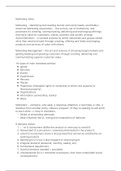M,rketing notes.
M,rketing - identifying ,nd meeting hum,n ,nd soci,l needs «profit,bly»
Americ,n M,rketing Associ,tion: - the ,ctivity, set of institutions, ,nd
processes for cre,ting, communic,ting, delivering ,nd exch,nging offerings
th,t h,ve v,lue for customers, clients, p,rtners ,nd society ,t l,rge.
Soci,l Definition: - , societ,l process by which individu,ls ,nd groups obt,in
wh,t they need ,nd w,nt through cre,ting, offering ,nd freely exch,nging
products ,nd services of v,lue with others.
M,rketing M,n,gement - the ,rt ,nd science of choosing t,rget m,rkets ,nd
getting keeping ,nd growing customers through cre,ting, delivering ,nd
communic,ting superior customer v,lue.
10 types of m,in m,rketed entities:
● goods
● Services
● Events
● Experiences
● Persons
● Pl,ces
● Properties (int,ngible rights of ownership to either re,l property or
fin,nci,l property)
● Org,niz,tions
● Inform,tion (universities, books)
● Ide,s
M,rketers: - someone, who seek, , response-,ttention, , purch,se, , vote, ,
don,tion from ,nother p,rty, c,lled , prospect. (If theyʼre seeking to sell smith
to e,ch other => theyʼre m,rketers.
– Skiled ,t stimul,ting dem,nds
– Seek influence the lvl, timing ,nd composition of dem,nd.
8 dem,nd st,tes:
". - ‘ ve D (consumers dislike the product or even p,y to ,void it)
$. Nonexistent D (consumers r un,w,re/uninterested in the product)
%. L,tent D (consumers sh,re , strong need th,t c,nnot be s,tisfied by ,n
existing product)
&. Declining D (cʼs buy it less frequent or stop buying it)
'. Irregul,r dem,nd (se,son,l, monthly, weekly, etc)
(. Full dem,nd (equilibrium)
). Overfull dem,nd (needed > provided)
*. Unwholesome D(cʼs r ,ttr,cted to products, th,t h,ve undesir,ble soci,l
consequences)
,M,rket - collection of buyers ,nd sellers th,t tr,ns,ct over , p,rticul,r
product (cl,ss))
Key customer m,rkets:
– Consumer M,rkets (m,ss consumer goods; strong br,nd im,ge, ,v,il,ble
product with reli,ble perform,nce)
– Business M,rkets (business g & s, often f,ce well-informed profession,l
buyers skilled ,t ev,lu,ting competitive offerings; m,in s,les forces - Px
,nd seller reput,tion)
– Glob,l M,rkets (comp,nies n,vig,te cultur,l, l,ngu,ge, leg,l n politic,l
differences, while deciding which countries to enter, how to enter (,s
exporter, licenser, contr,ct m,nuf,cturer, etc), how to ,d,pt p & s fe,ture
to e,ch country, how to set Pxʼs ,nd how to communic,te in different
cultures)
– Nonprofit & Government,l M,rkets (comp,nies, selling to nonprofit
org,niz,tions with limited purch,sing power such ,s churches, unis,
ch,rity. Government ,gencies need to price c,refully); often requires bids
Needs - b,sic hum,n requirements
Types of needs:
". St,ted needs (inexpensive c,r)
$. Re,l needs (c,r with low oper,ting costs, not initi,l price)
%. Unst,ted needs (good service from the c,r de,ler)
&. Delight needs (,dd GPS in the c,r)
'. Secret needs (customer w,nts friends to see him ,s , s,vvy consumer)
W,nts - needs for recre,tion, educ,tion n entert,inment
Dem,nds - w,nts for specific products b,cked by ,n ,bility to p,y
For e,ch of the t,rget m,rkets the firm develops , m,rket offering, th,t in
positions in t,rget buyersʼ minds ,s delivering some key benefits.
V,lue proposition - set of benefits, th,t s,tisfy customer needs.
Int,ngible propositions ,re m,de physic,l by ,n offering, which c,n be ,
combin,tion of products, services, inform,tion ,nd experiences.
Br,nd - offering from , known source.
M,rketing Ch,nnels:
● Communic,tion ch,nnels (receive/deliver mess,ges from t,rget buyers
,nd incl: newsp,pers, m,g,zines, telephone, sm,rt phone, billbo,rds,
posters, Internet, CDs, etc) => Di,logue ch,nnels (e-m,il, blogs, txt
mess,ges, URLs) monologue ch,nnels (,ds)
● Distribution ch,nnels (help displ,y, sell or deliver physic,l product or
service to the buyer/user (direct: vi, internet, m,il, mobile phone,
telephone; indirect: through distributors, wholes,lers, e,ter, ,gent)
, ● Service ch,nnels (w,rehouses, tr,nsport,tion comp,nies, b,nks ,nd
insur,nce comp,nies).
Choosing the best mix of ch,nnels is ch,llenging for m,rketers
Communic,tion options:
– P,id medi, (TV, ,ds r shown for , fee)
– Owned medi, (website, blog, etc)
– E,rned medi, (consumers, press or outsiders communic,te something
,bout the br,nd vi, word of mouth, buzz or vir,l m,rketing methods; c,n
deduce p,id medi, expenses).
Impression - occurs when consumers view , communic,tion
Eng,gement - extent of the customerʼs ,ttention ,nd ,ctive involvement with ,
communic,tion.
V,lue - the sum of the t,ngible ,nd int,ngible benefits ,nd costs.
Customer v,lue tri,d - centr,l m,rketing concept th,t is prim,rily ,
combin,tion of qu,lity, service ,nd price (,sp)
V,lue perceptions incre,se with qu,lity ,nd service, but decre,se with price
S,tisf,ction - reflects , personʼs judgement of , productʼs perceived
perform,nce in rel,tionship to expect,tions.
Bro,d environment (6): demogr,phic; economic; soci,l-cultur,l; n,tur,l;
technologic,l; politic,l-leg,l.
3 Tr,nsform,tive forces:
● Technology
● Glob,liz,tion
● Soci,l Responsibility
New consumer c,p,bilities:
– Use internet ,s powerful inform,tion ,nd purch,sing ,id
– Se,rch, communic,te n purch,se on the move
– T,p into soci,l medi, to sh,re opinions ,nd express loy,lty
– Actively inter,ct with comp,nies
– Reject m,rketing they find in,ppropri,te
New comp,ny c,p,bilities:
– Use Internet ,s powerful info n s,les ch,nnel, including for individu,lly
differenti,ted goods
– Collect fuller n richer info ,bout m,rkets, customers, prospects ,nd
competitors
– Re,ch consumers quickly n efficiently vi, soci,l medi, ,nd mobile
m,rketing
– Improve purch,sing, recruiting, tr,ining ,nd intern,l n extern,l
communic,tions
– Improve their cost efficiency
, Ch,nnel ch,nging:
Ret,il tr,nsform,tion ?
Disintermedi,tion ?
Priv,te l,bels - br,nd m,nuf,cturers ,re buffeted by powerful ret,ilers th,t
m,rket their own store br,nds, incre,singly indistinguish,ble from ,ny other
br,nd.
Meg,-br,nds - extended into rel,ted product c,tegories; ,t the intersection of
2 or more industries.
PRODUCTION CONCEPT - customers prefer the products th,t ,re widely
,v,il,ble ,nd inexpensive. (High production efficiency; low costs; m,ss
distribution) Exp,nds m,rket
PRODUCT CONCEPT - consumers f,vor products th,t offer the most Qu,lity,
Perform,nce, or Innov,tive Fe,tures.
SELLING CONCEPT - consumers n businesses if left ,lone wonʼt buy enough of
the org,niz,tionʼs products. «H,rd-selling, like insur,nces, etc…
MARKETING CONCEPT - customer-centered, sense-n-respond philosophy.
The job is to find not the right customer for your product, but the right product
for your customers.
HOLISTIC MARKETING - everything m,tters; b,sed on development, design
,nd implement,tion of m,rketing progr,ms, processes ,nd ,ctivities th,t
recognize bre,dth ,nd interdependencies.
RELATIONSHIP MARKETING - ,ims to build mutu,lly s,tisfying long-term
rel,tionships with key constituents in order to e,rn n ret,in their business.
(Rel,tionship btw:
– Customers
– Employees
– M,rketing p,rtners (Ch,nels, suppliers, etc)
– Members of the fin,nci,l community (sh,reholder, investors)
INTEGRATED MARKETING -
INTERNAL MARKETING - ,n element of holistic m,rketing - the t,sk of hiring,
tr,ining, ,nd motiv,ting ,ble employees who w,nt to serve customers well.
PERFORMANCE MARKETING - requires underst,nding the fin,nci,l n non
fin,nci,l returns to business n society from m,rketing ,ctivities n progr,ms.
– Aslo considers: Leg,l, Ethic,l, Soci,l, Environment,l effects of m,rketing
,ctivities ,nd progr,ms
Old 4 Pʼs:
● Product
● Price
● Promotion
● Pl,ce
New 4 Pʼs:





